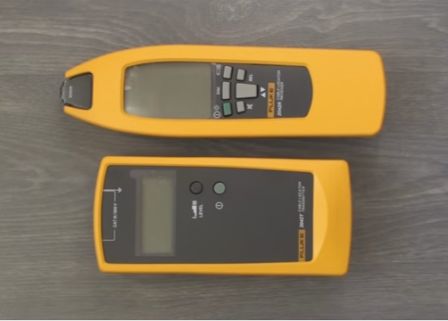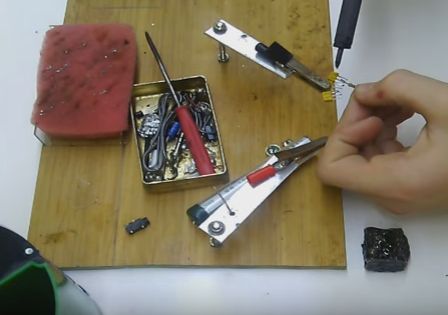Categories: Featured Articles » Sharing experience
Number of views: 23810
Comments on the article: 0
How to find wiring in the wall
 Concealed wiring is a type of wiring that provides for the installation of a cable (wire) of the wiring lines in the wall - under a layer of plaster or other finishing material. Such wiring from the point of view of aesthetics is most preferable, since the cable routing is not visible. But at the same time, this feature of hidden electrical wiring creates additional problems if it is necessary to search for cable locations in case of damage to a particular wiring line or if it is necessary to replace the wiring during repairs in the home.
Concealed wiring is a type of wiring that provides for the installation of a cable (wire) of the wiring lines in the wall - under a layer of plaster or other finishing material. Such wiring from the point of view of aesthetics is most preferable, since the cable routing is not visible. But at the same time, this feature of hidden electrical wiring creates additional problems if it is necessary to search for cable locations in case of damage to a particular wiring line or if it is necessary to replace the wiring during repairs in the home.
Why else do you need to know the wiring location?
Very often, when mounting various interior elements on the wall (wall cabinets, paintings, shelves, TV mounts, etc.), fasteners get into the cable (wire), which leads to its damage. Even more dangerous is that in the process of drilling holes in the wall and getting into the cable, there is a high probability of electric shock to a person.
In order to avoid the occurrence of these negative situations, if you need to fix one or another element on the wall, you must first search for places of wire laying and, taking this into account, adjust the mounting locations of the fasteners. In this article, we consider possible ways to search for hidden wiring.

Indirect method for finding hidden wiring
The first method to consider is indirect method. This method does not provide for the use of any tools or devices. There are generally accepted rules and regulations, according to which the wiring is carried out, we list the main ones:
-
all electrical wiring lines must pass strictly vertically or strictly horizontally with respect to architectural and construction lines;
-
the cable is laid below the ceiling slabs by 150 mm;
-
the cable running along the window beams should be located no closer than 50 mm;
-
in walls made of concrete, reinforced concrete blocks, the cable is usually located in special grooves provided in the plates, in inter-unit seams, and in the absence of such a possibility, the cable is laid in the gates;
-
in the presence of voids in the floor slabs, it is recommended to lay the cable in them. In this case, lighting lines can be laid directly to the lighting devices, as well as other electrical wiring lines;
-
the distance between the cable line of the wiring and the pipeline should be at least 50 mm - for pipelines of water supply, sewage and at least 250 mm - for gas pipelines and heating pipes.
That is, if you are guided by these standards, then you can easily determine the location of the laying of a particular line of wiring. For example, from the outlet, the cable goes up the wall strictly vertically, then, 20 cm below the ceiling, it turns towards the junction box, etc.
The only disadvantage of this method is that the wiring may not be mounted in accordance with the standards and, accordingly, the cable may actually be located in a completely different place.
Often, in order to save wires when installing wiring, the cable is laid along the shortest route, that is, not strictly horizontally and vertically with bends at right angles, but, for example, diagonally, with a straight line from the junction box to the outlet. Also, if the wiring diagram is quite complicated, then the place of passage of certain lines is impossible or there is a high probability of making an error.
That is, the indirect method does not give a 100% guarantee that the cable passes in this place.This method is well suited if you need to carry out work to replace the wiring - you can immediately start opening the strobes, based on the above rules, and in the process of dismantling the cable, you can clearly see where the cable goes and how to open it further. It often turns out that partially or fully the electrical wiring in the house was not installed in accordance with generally accepted rules and recommendations.
It should be noted right away that if you plan to completely replace the wiring, it is recommended that you install the new wiring strictly according to the rules, avoiding the old mistakes.
If you mount the wiring strictly according to the rules, then in the future it will be easy to navigate where this or that wiring line passes if it is necessary to fix various elements of the interior to the wall. And if it is necessary to repair or subsequently replace the wiring, it will be possible to easily find one or another route of the wiring cables.
In general, when replacing the wiring, it is recommended to leave the wiring diagram, which shows the exact location of the places for installing sockets, switches, intermediate junction boxes, cable routes of all wiring lines relative to other elements. In the future, such a scheme will greatly simplify the search for certain wiring elements in the walls.

Hidden wiring devices
If the above recommendations did not help to find the location of the wiring line in the wall, then you can not do without special devices.
Considering devices for searching for hidden wiring, it can be noted that the function of searching for wires in the wall can be carried out by an ordinary metal detector. In fact, this device indicates the presence of metal, and the wire in the wall is non-ferrous metal. This method is not suitable for walls made of reinforced concrete, since the metal detector will signal the presence of metal at any point on the wall.
One of the most common devices for finding hidden wiring is a device called a woodpecker. This device is able to find not only the place of wire laying, but also the exact place of its damage (break). With the help of this device, the process of finding and eliminating damage is greatly simplified. The so-called Woodpecker does not just search for metal objects, namely conductive ones, so it can be used to search for hidden electrical wiring everywhere, including in panel houses.

There are many different devices that allow you to find a wire in the wall. Some of the most popular of them are considered in this article: Devices for searching for hidden wiring.
At the same time, there is absolutely no guarantee that they will cope with the task.
Some devices are not able to determine the location of shielded cables or work on the principle of a metal detector, that is, they show the presence of not only electrical wires in the wall, but also other metal elements, for example, reinforcement in a reinforced concrete slab.

You can also make a device for finding hidden electrical wiring yourself. If you have the appropriate skills, this is not a problem - there are simple schemes for these devices on the Internet.
In finding the location of the cable passage in the wall will also help compact radio. To do this, you need to tune the receiver to a frequency of 100-150 kHz and, leading to the wall, listen to the nature of the noise. The appearance of extraneous sounds, hissing, crackling indicates the presence of a wire in this place. It is recommended that you plug in a power outlet that is powered by the desired wiring line, a powerful appliance so that the load current flows through the cable.
Another way is to use microphone audio system. By conducting a microphone along the wall, wire detection can be detected by the appearance of extraneous noise in the audio system. In this case, it is also recommended to include a powerful electrical appliance in the network.
It should be borne in mind that the method of searching for wires using a radio or microphone is characterized by a high error or, in some cases, may be completely inoperative.
You can also try to search for the location of the cable using the usual indicator screwdriver. Some types of screwdrivers respond to the cable laid in the wall.
If you need to search for hidden electrical wiring, you can turn to specialists who provide this service for help. The advantage of this option is accuracy in determining cable locations.
If you purchase the device for the first time and still do not know whether it works or not, then an experienced electrician will probably already have a time-tested device that will allow you to accurately determine not only the location of the wiring in the wall, but also the exact place of its damage, if such necessary. Therefore, before going to the store for the device, you should think about the appropriateness of such a purchase.
See also at bgv.electricianexp.com
:
